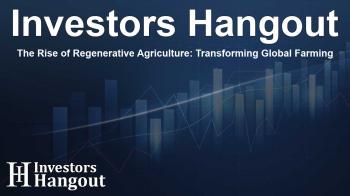The Rise of Regenerative Agriculture: Transforming Global Farming

Transforming Agriculture Through Sustainable Practices
Regenerative agriculture is reshaping the agricultural landscape, valued at USD 10.63 billion in 2024 and projected to grow significantly. This sector is expected to reach USD 30.3 billion by 2032, illustrating a substantial shift towards sustainable farming practices that emphasize soil health and biodiversity.
Climate-Smart Farming and Its Impact
Promoting sustainable agricultural practices has never been more crucial as the climate crisis escalates. Farmers worldwide are embracing regenerative techniques that not only work toward restoring ecosystem health but also aim to secure food production as populations rise. This shift reflects a fundamental change in the approach to agriculture, focusing on resilience and sustainability.
Enhancing Soil Health
Regenerative agriculture focuses on rebuilding soil organic matter, boosting its capacity to retain water, and supporting natural nutrient cycling. Practices like cover cropping, rotational grazing, and minimal tillage contribute to creating robust soil microbiomes, thereby enhancing crop yields while capturing atmospheric carbon.
Revenue Opportunities Through Carbon Sequestration
As the carbon credit market expands, farmers can access new income sources by adopting practices that sequester carbon dioxide. Initiatives from corporations and government programs encourage the integration of soil-building methods into different farming operations, making regenerative agriculture financially viable.
Government Support and Policy Frameworks
National climate action plans provide a robust foundation for sustainable agricultural practices. Policy initiatives, such as those from the European Union and climate-smart agriculture agendas, offer financial incentives for farmers transitioning to regenerative practices, highlighting farming's role in achieving carbon neutrality and supporting rural economies.
Market Growth of Regenerative Practices
Among various regenerative practices, cover cropping is rapidly gaining traction. Advances in seed technology and precision planting make cover crops indispensable for modern farming, enhancing soil health through functions such as nitrogen fixation and erosion control.
Crop Production Leading the Market
Crop production applications command the largest share of market revenue, fostering soil fertility, decreasing input costs, and improving crop adaptability to climate variability. The consumer demand for sustainable food continues to create opportunities for organically grown crops, supported by substantial investments in regenerative agricultural supply chains.
Industry Innovations and Sector Dynamics
The food and beverage sector remains the main end-user segment, implementing regenerative agriculture principles across supply chains to bolster sustainability. Plant-based food systems further encourage regenerative practices by utilizing diverse crop rotations and innovative agricultural strategies to meet changing consumer preferences.
Pharmaceutical Growth in Sustainable Practices
There is a burgeoning demand in the pharmaceutical and nutraceutical industries for naturally derived ingredients, creating a demand for sustainable cultivation. Regenerative practices ensure a consistent quality of medicinal plants while supporting biodiversity and preserving essential traditional knowledge.
Regional Market Insights and Growth Trajectories
North America is a frontrunner in the regenerative agriculture market, with substantial investments bolstering climate-smart agriculture initiatives. The adoption of regenerative methods in grain production and ranch operations showcases the economic and environmental benefits inherent in these practices.
Innovation Across Europe and Asia-Pacific
Developed regions like Europe lead in technological advancements within regenerative agriculture, while Asia-Pacific countries experience rapid growth as smallholder farmers implement new practices with support from development initiatives. Nations like India and China embrace larger programs to enhance food security while addressing climate change.
Technological Advances Optimizing Agriculture
The integration of precision agriculture technologies with regenerative practices opens a new era of farming facilitated by data-driven decisions. GPS-guided equipment and soil monitoring systems empower farmers with insights for maximizing the benefits of regenerative approaches.
Biological Enhancements in Soil Management
Utilizing advanced biological solutions such as microbial inoculants and biofertilizers significantly improves soil health and reduces reliance on synthetic inputs. These interventions not only support regenerative practices but also promote the rapid development of soil organic matter.
Key Players Shaping the Future
Collaboration among agricultural input companies, technology innovators, and sustainability-focused organizations is fostering growth in the regenerative agriculture market, with leading players actively contributing to advancements in this vital sector.
Frequently Asked Questions
What is regenerative agriculture?
Regenerative agriculture focuses on restoring and enhancing soil health, biodiversity, and ecosystem vitality through sustainable farming practices.
How is the regenerative agriculture market expected to grow?
The market is projected to evolve from USD 10.63 billion in 2024 to USD 30.3 billion by 2032, reflecting increasing demand for sustainable farming methods.
What are some common practices in regenerative agriculture?
Key practices include cover cropping, rotational grazing, minimal tillage, and integrating biological solutions to improve soil health.
Why is government support important for regenerative agriculture?
Government policies provide essential financial incentives and frameworks that encourage farmers to adopt sustainable practices, addressing climate goals.
Who are the main players in the regenerative agriculture market?
Key players include major agricultural and food companies that are investing in sustainable sourcing and regenerative practices across supply chains.
About The Author
Contact Lucas Young privately here. Or send an email with ATTN: Lucas Young as the subject to contact@investorshangout.com.
About Investors Hangout
Investors Hangout is a leading online stock forum for financial discussion and learning, offering a wide range of free tools and resources. It draws in traders of all levels, who exchange market knowledge, investigate trading tactics, and keep an eye on industry developments in real time. Featuring financial articles, stock message boards, quotes, charts, company profiles, and live news updates. Through cooperative learning and a wealth of informational resources, it helps users from novices creating their first portfolios to experts honing their techniques. Join Investors Hangout today: https://investorshangout.com/
The content of this article is based on factual, publicly available information and does not represent legal, financial, or investment advice. Investors Hangout does not offer financial advice, and the author is not a licensed financial advisor. Consult a qualified advisor before making any financial or investment decisions based on this article. This article should not be considered advice to purchase, sell, or hold any securities or other investments. If any of the material provided here is inaccurate, please contact us for corrections.

